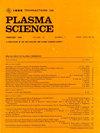Transmission Characteristics of Millimeter and Sub-Terahertz Channels Through Spatially Ripple Plasma Sheath Layers
IF 1.3
4区 物理与天体物理
Q3 PHYSICS, FLUIDS & PLASMAS
引用次数: 0
Abstract
The propagation of millimeter-wave (mmW) and sub-terahertz (THz) waves through plasma sheaths is a critical concern for maintaining communication with hypersonic vehicles, yet the impact of complex plasma structures on these high-frequency channels remains insufficiently understood. In this work, we aim to characterize the transmission properties of mmW and sub-THz channels through plasma sheaths with various density profiles and ripple structures, addressing the gap in knowledge regarding the effects of plasma inhomogeneities on channel propagation. We employ an approach combining inductively coupled plasma (ICP) data with transfer matrix methods (TMMs) to model propagation through both flat and rippled plasma layers. Our findings reveal that ripple structures in plasma sheaths significantly affect the channel performance, with periodic ripples reducing the cutoff frequency and introducing frequency-selective behavior, while random ripples cause more unpredictable transmission characteristics. Our results explore the impact of the arrangement of plasma density layers and the parameters of ripple structures (period and amplitude) on channel transmission, group velocity dispersion (GVD), and angular dependence of wave propagation. These results provide crucial insights for the design and optimization of communication systems for hypersonic vehicles, potentially enabling the development of adaptive technologies capable of maintaining reliable communication in complex plasma environments.毫米波和亚太赫兹通道通过空间纹波等离子鞘层的传输特性
毫米波(mmW)和次太赫兹(THz)波通过等离子体护套的传播是与高超音速飞行器保持通信的关键问题,但复杂等离子体结构对这些高频通道的影响仍未得到充分了解。在这项工作中,我们的目标是表征毫米波和亚太赫兹通道通过具有不同密度分布和纹波结构的等离子体护套的传输特性,解决关于等离子体不均匀性对通道传播影响的知识空白。我们采用一种将电感耦合等离子体(ICP)数据与传输矩阵方法(TMMs)相结合的方法来模拟平面和波纹等离子体层的传播。我们的研究结果表明,等离子体鞘层中的纹波结构显著影响信道性能,周期性纹波降低了截止频率并引入了频率选择行为,而随机纹波导致了更多不可预测的传输特性。我们的研究结果探讨了等离子体密度层的排列和纹波结构参数(周期和振幅)对通道传输、群速度色散(GVD)和波传播的角依赖性的影响。这些结果为高超声速飞行器通信系统的设计和优化提供了重要见解,有可能开发出能够在复杂等离子体环境中保持可靠通信的自适应技术。
本文章由计算机程序翻译,如有差异,请以英文原文为准。
求助全文
约1分钟内获得全文
求助全文
来源期刊

IEEE Transactions on Plasma Science
物理-物理:流体与等离子体
CiteScore
3.00
自引率
20.00%
发文量
538
审稿时长
3.8 months
期刊介绍:
The scope covers all aspects of the theory and application of plasma science. It includes the following areas: magnetohydrodynamics; thermionics and plasma diodes; basic plasma phenomena; gaseous electronics; microwave/plasma interaction; electron, ion, and plasma sources; space plasmas; intense electron and ion beams; laser-plasma interactions; plasma diagnostics; plasma chemistry and processing; solid-state plasmas; plasma heating; plasma for controlled fusion research; high energy density plasmas; industrial/commercial applications of plasma physics; plasma waves and instabilities; and high power microwave and submillimeter wave generation.
 求助内容:
求助内容: 应助结果提醒方式:
应助结果提醒方式:


